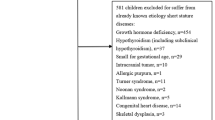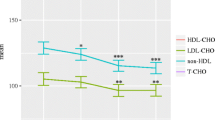Abstract
Context
Noonan syndrome (NS) is characterized by short stature and elevated risk of lymphedema. The mechanism underlying lymphedema may be mediated by vascular endothelial growth factors (VEGFs).
Objective
To assess the effect of growth hormone (GH) treatment on plasma insulin-like growth factor (IGF)-1, VEGF-A and VEGF-C levels in patients with NS as compared to short GH-sufficient children.
Design
Retrospective, comparative.
Setting
Endocrinology department of a tertiary pediatric medical center.
Patients and methods
Plasma IGF-1, VEGF-A and VEGF-C levels were measured before and during GH treatment in 6 patients with NS and 18 age-matched short subjects (Turner, idiopathic short stature and small for gestational age).
Main outcome measures
Changes in plasma VEGF and IGF-1 levels.
Results
Baseline IGF-1 SDS levels were slightly lower in NS patients compared with controls; IGF-1 response to GH therapy was markedly lower in NS patients compared with controls (p = 0.017). Mean baseline VEGF-A levels were similar in NS patients and controls whilst mean baseline VEGF-C levels were significantly lower in the NS group as compared with controls (p = 0.022). Plasma VEGF-A and VEGF-C levels did not significantly change during GH treatment in the study cohort. No correlation was found between VEGF-C levels and levels of IGF-1, VEGF-A and auxological parameters, either before or during GH administration.
Conclusion
Children with NS have a distinct growth factor profile including low basal VEGF-C and flattened IGF-1 response to GH. Further studies are needed to confirm our findings and to elucidate the interaction between VEGF-C levels and lymphedema.


Similar content being viewed by others
References
Ji RC (2008) Lymphatic endothelial cells, lymphedematous lymphangiogenesis, and molecular control of edema formation. Lymphat Res Biol 6(3–4):123–137. doi:10.1089/lrb.2008.1005
Ferrell RE, Finegold DN (2008) Research perspectives in inherited lymphatic disease: an update. Ann N Y Acad Sci 1131:134–139. doi:10.1196/annals.1413.012
Coso S, Zeng Y, Opeskin K, Williams ED (2012) Vascular endothelial growth factor receptor-3 directly interacts with phosphatidylinositol 3-kinase to regulate lymphangiogenesis. PLoS ONE 7(6):e39558. doi:10.1371/journal.pone.0039558
Aoki Y, Matsubara Y (2013) Ras/MAPK syndromes and childhood hemato–oncological diseases. Int J Hematol 97(1):30–36. doi:10.1007/s12185-012-1239-y
Romano AA, Dana K, Bakker B, Davis DA, Hunold JJ, Jacobs J, Lippe B (2009) Growth response, near-adult height, and patterns of growth and puberty in patients with Noonan syndrome treated with growth hormone. J Clin Endocrinol Metab 94(7):2338–2344. doi:10.1210/jc.2008-2094
Noordam C, Peer PG, Francois I, De Schepper J, van den Burgt I, Otten BJ (2008) Long-term GH treatment improves adult height in children with Noonan syndrome with and without mutations in protein tyrosine phosphatase, non-receptor-type 11. Eur J Endocrinol 159(3):203–208. doi:10.1530/EJE-08-0413
Osio D, Dahlgren J, Wikland KA, Westphal O (2005) Improved final height with long-term growth hormone treatment in Noonan syndrome. Acta Paediatr 94(9):1232–1237. doi:10.1080/08035250510031476
Raaijmakers R, Noordam C, Karagiannis G, Gregory JW, Hertel NT, Sipila I, Otten BJ (2008) Response to growth hormone treatment and final height in Noonan syndrome in a large cohort of patients in the KIGS database. J Pediatr Endocrinol Metab JPEM 21(3):267–273
Hasegawa K, Nagaoka Y, Maruyama H, Aya K, Tanaka H, Morishima T (2009) Late-onset lymphedema and protein-losing enteropathy with Noonan Syndrome. Clin Pediatr Endocrinol 18(3):87–93. doi:10.1297/cpe.18.87 Official journal of the Japanese Society for Pediatric Endocrinology
Blethen SL, Allen DB, Graves D, August G, Moshang T, Rosenfeld R (1996) Safety of recombinant deoxyribonucleic acid-derived growth hormone: the National Cooperative Growth Study experience. J Clin Endocrinol Metab 81(5):1704–1710. doi:10.1210/jcem.81.5.8626820
Struman I, Bentzien F, Lee H, Mainfroid V, D’Angelo G, Goffin V, Weiner RI, Martial JA (1999) Opposing actions of intact and N-terminal fragments of the human prolactin/growth hormone family members on angiogenesis: an efficient mechanism for the regulation of angiogenesis. Proc Natl Acad Sci U S A 96(4):1246–1251. doi:10.1073/pnas.96.4.1246
Akagi Y, Liu W, Zebrowski B, Xie K, Ellis LM (1998) Regulation of vascular endothelial growth factor expression in human colon cancer by insulin-like growth factor-I. Cancer Res 58(17):4008–4014
Poulaki V, Mitsiades CS, McMullan C, Sykoutri D, Fanourakis G, Kotoula V, Tseleni-Balafouta S, Koutras DA, Mitsiades N (2003) Regulation of vascular endothelial growth factor expression by insulin-like growth factor I in thyroid carcinomas. J Clin Endocrinol Metab 88(11):5392–5398. doi:10.1210/jc.2003-030389
Brunet-Dunand SE, Vouyovitch C, Araneda S, Pandey V, Vidal LJ, Print C, Mertani HC, Lobie PE, Perry JK (2009) Autocrine human growth hormone promotes tumor angiogenesis in mammary carcinoma. Endocrinology 150(3):1341–1352. doi:10.1210/en.2008-0608
Economou MA, Wu J, Vasilcanu D, Rosengren L, All-Ericsson C, van der Ploeg I, Menu E, Girnita L, Axelson M, Larsson O, Seregard S, Kvanta A (2008) Inhibition of VEGF secretion and experimental choroidal neovascularization by picropodophyllin (PPP), an inhibitor of the insulin-like growth factor-1 receptor. Invest Ophthalmol Vis Sci 49(6):2620–2626. doi:10.1167/iovs.07-0742
Ranke MB, Schweizer R, Elmlinger MW, Weber K, Binder G, Schwarze CP, Wollmann HA (2000) Significance of basal IGF-I, IGFBP-3 and IGFBP-2 measurements in the diagnostics of short stature in children. Horm Res Paediatr 54(2):60–68. doi:10.1159/000053233
Marshall WA, Tanner JM (1969) Variations in pattern of pubertal changes in girls. Arch Dis Child 44(235):291–303
Marshall WA, Tanner JM (1970) Variations in the pattern of pubertal changes in boys. Arch Dis Child 45(239):13–23
Kuczmarski RJ, Ogden CL, Grummer-Strawn LM, Flegal KM, Guo SS, Wei R, Mei Z, Curtin LR, Roche AF, Johnson CL (2000) CDC growth charts: United States. Adv Data 314:1–27
Dixon WJ (ed) (1993) BMDP statistical software manual, vol 1 and 2. University of California Press, Berkeley
Ferrell RE (2002) Research perspectives in inherited lymphatic disease. Ann N Y Acad Sci 979:39–51
Karkkainen MJ, Haiko P, Sainio K, Partanen J, Taipale J, Petrova TV, Jeltsch M, Jackson DG, Talikka M, Rauvala H, Betsholtz C, Alitalo K (2004) Vascular endothelial growth factor C is required for sprouting of the first lymphatic vessels from embryonic veins. Nat Immunol 5(1):74–80. doi:10.1038/ni1013
Silha JV, Krsek M, Hana V, Marek J, Weiss V, Jezkova J, Rosicka M, Jarkovska Z, Murphy LJ (2005) The effects of growth hormone status on circulating levels of vascular growth factors. Clin Endocrinol 63(1):79–86. doi:10.1111/j.1365-2265.2005.02303.x
Cheng D, Liang B, Li Y (2013) Serum vascular endothelial growth factor (VEGF-C) as a diagnostic and prognostic marker in patients with ovarian cancer. PLoS ONE 8(2):e55309. doi:10.1371/journal.pone.0055309
Kimura H, Kato H, Tanaka N, Inose T, Faried A, Sohda M, Nakajima M, Fukai Y, Miyazaki T, Masuda N, Manda R, Fukuchi M, Ojima H, Tsukada K, Kuwano H (2008) Preoperative serum vascular endothelial growth factor-C (VEGF-C) levels predict recurrence in patients with esophageal cancer. Anticancer Res 28(1A):165–169
Tartaglia M, Mehler EL, Goldberg R, Zampino G, Brunner HG, Kremer H, van der Burgt I, Crosby AH, Ion A, Jeffery S, Kalidas K, Patton MA, Kucherlapati RS, Gelb BD (2001) Mutations in PTPN11, encoding the protein tyrosine phosphatase SHP-2, cause Noonan syndrome. Nat Genet 29(4):465–468. doi:10.1038/ng772
Schubbert S, Zenker M, Rowe SL, Boll S, Klein C, Bollag G, van der Burgt I, Musante L, Kalscheuer V, Wehner LE, Nguyen H, West B, Zhang KY, Sistermans E, Rauch A, Niemeyer CM, Shannon K, Kratz CP (2006) Germline KRAS mutations cause Noonan syndrome. Nat Genet 38(3):331–336. doi:10.1038/ng1748
Pandit B, Sarkozy A, Pennacchio LA, Carta C, Oishi K, Martinelli S, Pogna EA, Schackwitz W, Ustaszewska A, Landstrom A, Bos JM, Ommen SR, Esposito G, Lepri F, Faul C, Mundel P, Lopez Siguero JP, Tenconi R, Selicorni A, Rossi C, Mazzanti L, Torrente I, Marino B, Digilio MC, Zampino G, Ackerman MJ, Dallapiccola B, Tartaglia M, Gelb BD (2007) Gain-of-function RAF1 mutations cause Noonan and LEOPARD syndromes with hypertrophic cardiomyopathy. Nat Genet 39(8):1007–1012. doi:10.1038/ng2073
Razzaque MA, Nishizawa T, Komoike Y, Yagi H, Furutani M, Amo R, Kamisago M, Momma K, Katayama H, Nakagawa M, Fujiwara Y, Matsushima M, Mizuno K, Tokuyama M, Hirota H, Muneuchi J, Higashinakagawa T, Matsuoka R (2007) Germline gain-of-function mutations in RAF1 cause Noonan syndrome. Nat Genet 39(8):1013–1017. doi:10.1038/ng2078
Sarkozy A, Carta C, Moretti S, Zampino G, Digilio MC, Pantaleoni F, Scioletti AP, Esposito G, Cordeddu V, Lepri F, Petrangeli V, Dentici ML, Mancini GM, Selicorni A, Rossi C, Mazzanti L, Marino B, Ferrero GB, Silengo MC, Memo L, Stanzial F, Faravelli F, Stuppia L, Puxeddu E, Gelb BD, Dallapiccola B, Tartaglia M (2009) Germline BRAF mutations in Noonan, LEOPARD, and cardiofaciocutaneous syndromes: molecular diversity and associated phenotypic spectrum. Hum Mutat 30(4):695–702. doi:10.1002/humu.20955
Tartaglia M, Pennacchio LA, Zhao C, Yadav KK, Fodale V, Sarkozy A, Pandit B, Oishi K, Martinelli S, Schackwitz W, Ustaszewska A, Martin J, Bristow J, Carta C, Lepri F, Neri C, Vasta I, Gibson K, Curry CJ, Siguero JP, Digilio MC, Zampino G, Dallapiccola B, Bar-Sagi D, Gelb BD (2007) Gain-of-function SOS1 mutations cause a distinctive form of Noonan syndrome. Nat Genet 39(1):75–79. doi:10.1038/ng1939
Roberts AE, Araki T, Swanson KD, Montgomery KT, Schiripo TA, Joshi VA, Li L, Yassin Y, Tamburino AM, Neel BG, Kucherlapati RS (2007) Germline gain-of-function mutations in SOS1 cause Noonan syndrome. Nat Genet 39(1):70–74. doi:10.1038/ng1926
Boucher CA, Sargent CA, Ogata T, Affara NA (2001) Breakpoint analysis of Turner patients with partial Xp deletions: implications for the lymphoedema gene location. J Med Genet 38(9):591–598. doi:10.1136/jmg.38.9.591
Ogata T, Sato S, Hasegawa Y, Kosaki K (2003) Lymphstasis in a boy with Noonan syndrome: implication for the development of skeletal features. Endocr J 50(3):319–324. doi:10.1507/endocrj.50.319
Oliveira CS, Alves C (2011) The role of the SHOX gene in the pathophysiology of Turner syndrome. Endocrinol Nutr 58(8):433–442. doi:10.1016/j.endonu.2011.06.005
Breen EC (2007) VEGF in biological control. J Cell Biochem 102(6):1358–1367. doi:10.1002/jcb.21579
De Rocca Serra-Nedelec A, Edouard T, Treguer K, Tajan M, Araki T, Dance M, Mus M, Montagner A, Tauber M, Salles JP, Valet P, Neel BG, Raynal P, Yart A (2012) Noonan syndrome-causing SHP2 mutants inhibit insulin-like growth factor 1 release via growth hormone-induced ERK hyperactivation, which contributes to short stature. Proc Natl Acad Sci U S A 109(11):4257–4262. doi:10.1073/pnas.1119803109
Tang Y, Zhang D, Fallavollita L, Brodt P (2003) Vascular endothelial growth factor C expression and lymph node metastasis are regulated by the type I insulin-like growth factor receptor. Cancer Res 63(6):1166–1171
Bjorndahl M, Cao R, Nissen LJ, Clasper S, Johnson LA, Xue Y, Zhou Z, Jackson D, Hansen AJ, Cao Y (2005) Insulin-like growth factors 1 and 2 induce lymphangiogenesis in vivo. Proc Natl Acad Sci U S A 102(43):15593–15598. doi:10.1073/pnas.0507865102
Zhu C, Qi X, Chen Y, Sun B, Dai Y, Gu Y (2011) PI3 K/Akt and MAPK/ERK1/2 signaling pathways are involved in IGF-1-induced VEGF-C upregulation in breast cancer. J Cancer Res Clin Oncol 137(11):1587–1594. doi:10.1007/s00432-011-1049-2
Acknowledgments
The authors thank Mrs. Pearl Lilos for the statistical analysis and Mrs. Gloria Ginzach for her editorial assistance. Grants: this work was supported by a grant from the Lydia Eviatar Foundation for Clinical Research by Residents of Schneider Children’s Medical Center of Israel.
Conflict of interest
The authors have declared no conflict of interest.
Author information
Authors and Affiliations
Corresponding author
Additional information
S. Fuchs and G. Gat-Yablonski have contributed equally to this work.
Rights and permissions
About this article
Cite this article
Fuchs, S., Gat-Yablonski, G., Shtaif, B. et al. Vascular endothelial growth factor (VEGF) levels in short, GH treated children: a distinct pattern of VEGF-C in Noonan syndrome. J Endocrinol Invest 38, 399–406 (2015). https://doi.org/10.1007/s40618-014-0194-2
Received:
Accepted:
Published:
Issue Date:
DOI: https://doi.org/10.1007/s40618-014-0194-2




